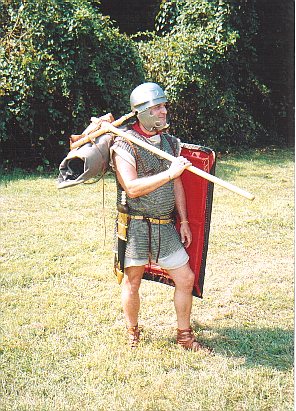Lorica hamata
(from old site, author unknown) |
m (Adding cite tag) |
||
| Line 1: | Line 1: | ||
| + | {{Cite-many}} | ||
| + | |||
[[Image:MariusMule0.jpg|right]] | [[Image:MariusMule0.jpg|right]] | ||
Latest revision as of 11:17, 23 June 2024
Please help! Providing citations in accordance with our guidelines will improve the quality of our site.
Mail was the standard armor before the introduction of the lorica segmentata, and it continued in use among auxiliaries and legionaries throughout the Imperial period. It is not known what the ratio of hamata to segmentata might have been in the legions during the mid-first century, but a minority of mailshirts in the ranks is certainly acceptable. Mail was also worn by standard-bearers, musicians, and centurions, and of course by auxiliary troops.
Roman mail was made of either iron or bronze, with rings as small as 1/8" in diameter. Frequently, half the rings were solid (either punched from sheet metal, or cut from wire and welded shut) while the rest were riveted shut. Occasionally the rings were simply butted closed, without rivets.
Reproductions
Reproduction mail is usually made from galvanized steel wire, 16 guage being a good thickness for modern purposes. Rings may be up to 5/8" in outside diameter, but the smaller the better. While the galvanization protects against rust, especially during construction, it is best to remove it when the shirt is complete (except for the leather!) for a more authentic appearance. Battery acid has been used, but rolling the mail in a barrel of sand should also work. An alternative to winding and cutting wire for rings is to buy 20 to 30 pounds of small washers, half normal and half split. This is more costly but much quicker, and the flat cross-section of the rings may be more authentic than round wire.
The typical mailshirt is sleeveless or has short (approximately 5") sleeves, and reaches to about mid-thigh. The shoulder doubling, shaped like a square-bottomed U, is attached to the back by a single row of rings. This doubling can be edged with leather (2-5 ounce), which is folded over the edges and stitched through. Riveted to the center of the chest is a pair of S-shaped hooks of iron or bronze (or a single hook of that shape), which hook onto a button or stud on each flap. For auxiliary cavalry and some officers, the shoulder doubling is more of a circular cape, joined to the body around the neckhole. Auxiliary infantry seem to have dispensed with shoulder doublings by this time.
Master Index > English > Nova Roma
Master Index > English > Nova Roma
Master Index > Maintenance Categories > Pages to be deleted
Master Index > Maintenance Categories > Pages to be deleted > Via Romana > Roman Clothing and Equipment
Master Index > Maintenance Categories > Pages to be deleted > Via Romana > Roman Clothing and Equipment > Roman Armour
Master Index > Maintenance Categories > Pages with content needing verification
